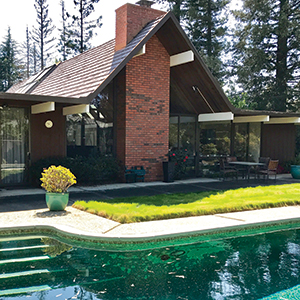There’s at least one Eichler home for sale right now in Sunnyvale. It’s a four-bedroom, two-bath listed at just under $2 million. What a difference seven decades make. In a 1949 ad on display in Eichler Homes: Modernism for the Masses, you could put $600 down near Saratoga Road in the same city and own one of “36 Strikingly Beautiful NEW 3 BEDROOM HOMES!”
That’s about $6,000 today—in an age when the median down payment on a South Bay home approaches the $200,000 mark. But the past affordability of Eichler homes is just one set of facts presented at the Los Altos History Museum’s new exhibit about the builder Joseph Eichler and his enterprising vision.
When I first read about the exhibit, I imagined the curatorial focus would center on photography. I expected to find large framed prints of Eichler homes, both interior and exterior shots, like the ones made by the late California photographer Larry Sultan. But he made visual stories out of the interplay between his subjects and the houses they lived in, not just the buildings themselves. While there are several photographs of houses at the museum, they’re not front and center. Nor do the photographs reveal much about the specific lives of the owners.
Instead, the museum opts for a more straightforward account of the notable midcentury modern players, their philosophy and aesthetic. Large posters mounted on the walls offer brief history lessons summarizing the development and subsequent construction of nearly 11,000 homes between 1947 and 1974, the year of Eichler’s death. According to one, the tract home’s anonymity and sameness was part of the appeal: “Eichler tracts were designed with wide streets that invited engagement among the neighbors.” There are also short paragraphs about other topics like preservation, local projects, biographies of Eichler himself and Robert Anshen, A. Quincy Jones, and Frederick E. Emmons, the architects with whom he most frequently collaborated.
Eichler’s philosophy is summed up on one poster: “He was determined to offer houses and neighborhoods that provided families a way to live more fully than they do when housing is considered to be nothing more than mere shelter.” The aim was to make a well-designed, contemporary home affordable for the average Joe.
Eichler Homes also sets out to reacquaint the 21st century visitor with the midcentury lifestyle. While the exhibit’s tone is reverential toward the houses, equal space is also given to home furnishings. Glass cases contain candleholders, dishware, cutlery, teapots, vases and one gleaming toaster. The inclusion of I’m OK-You’re OK, the 1969 self-help book, is particularly helpful in locating the psyche of that era’s residents. You can picture husbands and wives bringing their copies of the book down to Big Sur for a weekend of healing at the Esalen Institute.
Standing out from all the bric-a-brac are a few of the iconic chairs designed by Ray and Charles Eames. There’s even a splendid Hang It All, one of their fanciful, multicolored coat hangers. Owning an Eichler home, the exhibit underlines, also meant owning furniture that not only paired well with the building materials but also looked and felt like it belonged there.
For some, this style of architecture—the minimalism, the confluence of indoors and out, the floor-to-ceiling glass—has little appeal. For others like Margot Gordon, “it was love at first sight.” Her testimonial also hangs in the museum. In 1961, Gordon and her husband bought their first one in Sunnyvale, their second five years later in Los Altos. Both times Eichler himself agreed to extend their down payments so they could afford to buy into the housing market. Eichler Homes offers a convincing array of evidence that they don’t build houses like they used to, nor builders either.
Eichler Homes
Thru Oct 8, Free
Los Altos History Museum



